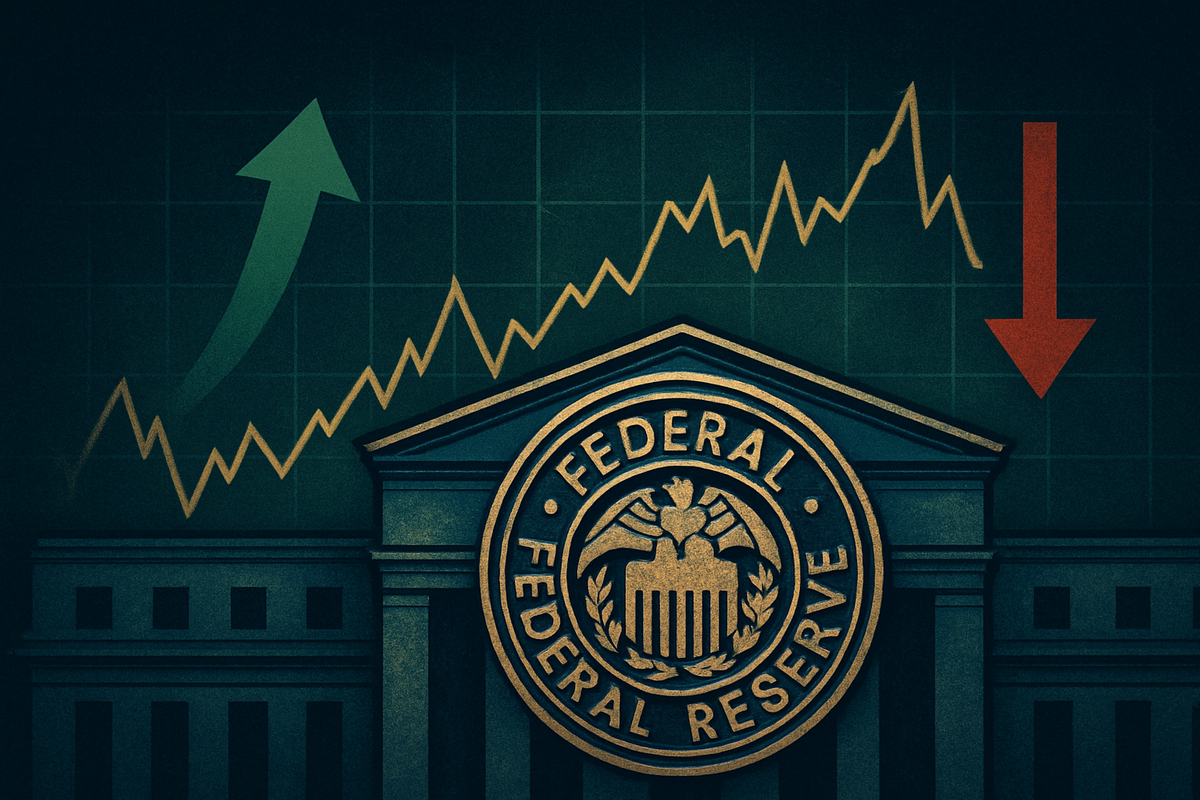
Washington D.C. – October 28, 2025 – The financial world is holding its breath as the U.S. Federal Reserve's Federal Open Market Committee (FOMC) commenced its crucial two-day policy meeting today, with a highly anticipated interest rate decision slated for tomorrow, October 29, 2025. This gathering comes at a pivotal moment for the U.S. economy, as policymakers grapple with moderating economic activity, a resilient yet slowing labor market, and persistently elevated inflation. The market is overwhelmingly pricing in a 25-basis-point reduction in the federal funds rate, a move that would mark the second consecutive cut and potentially reshape the investment landscape for months to come.
The outcome of this meeting and, more significantly, the accompanying forward guidance from Fed Chair Jerome Powell, are expected to send palpable ripples across global financial markets. Investors are keenly watching for signals regarding the future trajectory of monetary policy, particularly how the Fed intends to balance its dual mandate of achieving maximum employment and stable prices. Any deviation from market expectations, whether more hawkish or dovish, could trigger significant volatility, underscoring the profound influence of the central bank's decisions on asset valuations and economic sentiment.
The Fed's Deliberation: Navigating a Complex Economic Tapestry
The ongoing FOMC meeting is set against a backdrop of complex and sometimes conflicting economic indicators. Discussions within the committee are undoubtedly centering on the latest inflation data, particularly the September Consumer Price Index (CPI), which showed headline inflation moderating to 3.0% year-over-year. This slight easing in inflationary pressures provides the Fed with some much-needed breathing room to consider accommodative measures. However, inflation remains above the Fed's long-term 2% target, a point of contention among some committee members who advocate for continued vigilance.
On the employment front, while the unemployment rate remains historically low, recent data suggests a moderation in job gains, signaling a potential cooling in the labor market. This softening, coupled with signs of broader economic moderation, has fueled market expectations for a rate cut. The federal government shutdown that preceded this meeting has also limited the availability of comprehensive economic data, making the Fed's internal assessments and supplemental surveys even more critical in shaping their decision-making process. The anticipated 25-basis-point cut would bring the federal funds rate target range to 3.75% to 4%, building on the initial reduction implemented in September 2025, which was a direct response to emerging signs of weakness in the labor market.
Beyond interest rates, the Fed's balance sheet policy, specifically quantitative tightening (QT), is also a key agenda item. The Fed has been steadily reducing its balance sheet by allowing maturing bonds and mortgage-backed securities to roll off without reinvestment. This process aims to drain liquidity from the financial system and tighten financial conditions. While the Fed has managed this process with consistent execution, concerns linger that an overly aggressive QT pace could exacerbate an economic slowdown, particularly if combined with weakening demand. Chair Powell's press conference tomorrow will be crucial for discerning the committee's consensus on both interest rates and the future pace of balance sheet reduction.
Initial market reactions leading up to this meeting have been largely bullish, with equity markets already rallying on the expectation of cheaper capital. This "risk-on" sentiment reflects investors' belief that lower borrowing costs will stimulate economic activity and boost corporate profits, making equities more attractive relative to other asset classes. However, the true test will come with the official announcement and the nuanced language of the FOMC statement, which will either validate or challenge these prevailing market sentiments.
Corporate Fortunes: Winners and Losers in a Shifting Rate Environment
The Federal Reserve's policy decisions, particularly on interest rates, act as a powerful current, lifting some sectors while creating headwinds for others. Should the anticipated 25-basis-point rate cut materialize, several sectors and public companies are poised to experience significant impacts.
Potential Winners:
- Technology and Growth Stocks: Companies in the technology sector, such as Apple (NASDAQ: AAPL), Microsoft (NASDAQ: MSFT), and emerging tech firms, often benefit disproportionately from lower interest rates. These companies typically rely on future earnings growth and often finance expansion through debt. Reduced borrowing costs make their future cash flows more valuable in present terms and lower the cost of capital for innovation and acquisition, potentially boosting valuations.
- Real Estate and Homebuilders: A reduction in interest rates directly translates to lower mortgage rates, which can stimulate housing demand. Homebuilders like D.R. Horton (NYSE: DHI) and Lennar Corporation (NYSE: LEN), along with real estate investment trusts (REITs) focused on residential properties, could see increased sales and improved profitability.
- Consumer Discretionary: Lower borrowing costs can also encourage consumer spending, particularly on big-ticket items. Companies in the consumer discretionary sector, including retailers like Amazon (NASDAQ: AMZN) and automotive manufacturers, might see an uptick in demand as consumers face lower financing costs for purchases.
- High-Leverage Companies: Businesses with significant debt on their balance sheets could see their interest expenses decrease, improving their net income and cash flow. This could be particularly beneficial for companies that have taken on debt for expansion or share buybacks.
Potential Losers (or those facing headwinds):
- Financial Institutions: Banks, such as JPMorgan Chase (NYSE: JPM) and Bank of America (NYSE: BAC), often thrive in higher interest rate environments, as they can earn larger net interest margins (the difference between what they pay on deposits and what they earn on loans). While rate cuts can stimulate loan demand, a shrinking net interest margin could compress profitability, especially if the cuts are aggressive or prolonged.
- Utilities and Income-Oriented Stocks: Sectors traditionally favored for their stable dividends, such as utilities (e.g., NextEra Energy (NYSE: NEE)) and consumer staples (e.g., Procter & Gamble (NYSE: PG)), might become less attractive. As interest rates fall, the yield on safer assets like bonds also decreases, but the relative attractiveness of dividend stocks can diminish if bond yields remain competitive or if investors seek higher growth in other sectors.
- Companies with Weak Fundamentals: While lower rates can provide a temporary reprieve, they may not fundamentally alter the trajectory of companies with poor business models, excessive debt, or declining market share. Investors might become more discerning, shifting capital towards stronger, more resilient businesses.
The impact will not be uniform, and the specific nuances of each company's balance sheet, growth prospects, and sector-specific dynamics will ultimately determine their individual performance in this evolving monetary policy landscape.
Broader Significance: A Shift in the Monetary Tides
The Federal Reserve's anticipated rate cut marks a significant pivot in monetary policy, signaling a potential shift from a tightening cycle to a more accommodative stance. This move fits into broader industry trends reflecting concerns about global economic slowdowns and the need to support domestic growth. The previous rate hike cycle, which began in early 2022, was primarily aimed at combating soaring inflation. Now, with inflation showing signs of moderation and the labor market cooling, the Fed appears to be recalibrating its focus towards sustaining economic expansion.
The potential ripple effects of this policy shift are far-reaching. Competitors and partners across various industries will need to re-evaluate their capital allocation strategies. For instance, businesses that have been delaying investment due to high borrowing costs may now find it more feasible to expand, potentially intensifying competition in certain markets. International markets will also feel the impact, as a lower U.S. interest rate could weaken the dollar, making U.S. exports more competitive but potentially increasing import costs. Emerging markets, in particular, often benefit from a weaker dollar and lower U.S. rates, as it eases their debt burdens denominated in dollars.
From a regulatory and policy perspective, a sustained period of lower interest rates could prompt discussions about fiscal policy. With monetary policy providing more stimulus, there might be less pressure on the government to enact large-scale fiscal packages. Conversely, if the rate cuts fail to significantly boost economic activity, calls for coordinated fiscal action could intensify. Historically, periods of rate cuts have often been associated with economic slowdowns or recessions, but they have also laid the groundwork for subsequent recoveries. The current situation, with inflation still elevated even as rates are cut, presents a unique challenge, drawing comparisons to periods where the Fed had to navigate stagflationary pressures. The key difference now is the Fed's enhanced communication strategies and its explicit dual mandate, which were not as clearly defined in earlier eras.
This policy adjustment also underscores the Fed's commitment to flexibility and data-dependence. The decision to cut rates after a period of tightening demonstrates the central bank's willingness to adapt its strategy in response to evolving economic conditions, rather than adhering rigidly to a predetermined path. This adaptability, while crucial for navigating uncertainty, also introduces an element of unpredictability that market participants must continually assess.
What Comes Next: Navigating the New Economic Terrain
The immediate aftermath of the Fed's decision tomorrow will likely see continued market volatility as investors fully digest the announcement and Chair Powell's forward guidance. In the short term, if the 25-basis-point cut is delivered as expected, and the guidance suggests a possibility of further cuts, the market could experience a sustained "risk-on" rally, favoring equities, particularly growth stocks. However, if the Fed adopts a more cautious tone, indicating a "wait-and-see" approach for future cuts, or if concerns about inflation resurface, market enthusiasm could be tempered.
In the long term, the trajectory of interest rates will largely depend on the evolution of inflation and employment data. Should inflation continue its downward trend while the labor market shows more significant signs of weakening, further rate cuts could be on the horizon in early 2026. Conversely, an unexpected resurgence of inflation or a stronger-than-anticipated rebound in economic activity could prompt the Fed to pause or even reverse course, though a return to aggressive tightening seems less likely in the immediate future.
Companies will need to consider strategic pivots and adaptations. Businesses with high levels of variable-rate debt should evaluate refinancing opportunities to lock in lower interest rates. Growth-oriented companies may find it an opportune time to accelerate investment in R&D, capital expenditures, or strategic acquisitions. Conversely, financial institutions will need to adjust their lending strategies and explore new revenue streams to mitigate the impact of potentially compressed net interest margins.
Market opportunities could emerge in sectors that are highly sensitive to interest rates, such as housing, automotive, and technology. Investors might also seek out dividend-paying stocks in defensive sectors if bond yields remain low, or explore international markets if a weaker dollar makes them more attractive. Challenges will include managing potential market overreactions, discerning genuine economic trends from noise, and navigating geopolitical uncertainties that could still influence economic stability. Potential scenarios range from a "soft landing" where the Fed successfully engineers a slowdown without a recession, to a more challenging environment if inflation proves stickier or the economy tips into a downturn despite rate cuts.
Wrap-Up: A Pivotal Moment for Markets and the Economy
The Federal Reserve's October 2025 policy meeting represents a pivotal moment for the U.S. economy and financial markets. The expected 25-basis-point rate cut, if confirmed, signifies a strategic shift by the central bank to support economic growth amidst moderating inflation and a cooling labor market. Key takeaways include the Fed's data-dependent approach, its willingness to pivot from tightening to easing, and the profound impact these decisions have on corporate profitability, consumer behavior, and investor sentiment.
Moving forward, the market's trajectory will be heavily influenced by the Fed's subsequent actions and communications. While the immediate outlook suggests a potential boost for equities, particularly growth-oriented sectors, investors should remain vigilant. The interplay between inflation, employment, and global economic developments will dictate the Fed's future path.
Ultimately, the significance and lasting impact of this meeting will be measured by its ability to foster a sustainable economic expansion while maintaining price stability. Investors should closely watch for further inflation data, labor market reports, and, crucially, any shifts in the Fed's forward guidance in the coming months. The central bank's delicate balancing act will continue to be the dominant narrative shaping financial markets.
This content is intended for informational purposes only and is not financial advice





